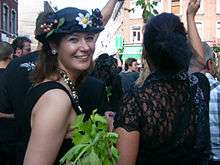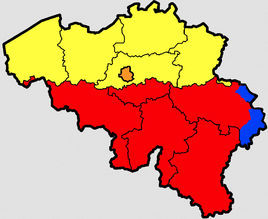Women in Belgium
 Two modern-day women in Belgium | |
| Gender Inequality Index[1] | |
|---|---|
| Value | 0.068 (2013) |
| Rank | 9th out of 152 |
| Maternal mortality (per 100,000) | 8 (2010) |
| Women in parliament | 38.9% (2013) |
| Females over 25 with secondary education | 77.5% (2012) |
| Women in labour force | 58% (employment rate OECD definition, 2015)[2] |
| Global Gender Gap Index[3] | |
| Value | 0.7684 (2013) |
| Rank | 11th out of 144 |

| Dutch-speaking |
French-speaking | ||
| German-speaking |
Bilingual FR/NL | ||
| Community: | Region: | ||
| Flemish | Flemish (Flanders) | ||
| Capital (Brussels) | |||
| French | |||
| Walloon | (Wallonia) | ||
| German-speaking | |||
Women in Belgium are European women who live in or are from Belgium. Generation after generation, Belgian women are able to close the "occupational gender gap". In younger generations, this is due to the increasing availability of "part-time jobs in services" for women. In 1999, the average earnings of a Belgian woman was 91 percent of the salary of a Belgian man. When not doing part-time jobs, Belgian women still "do more of the domestic work", depending on the agreement between female and male partners.[4]
Cultural background
Belgian culture is complex, because it has both aspects that are shared by most Belgians regardless of the language they speak, as well as differences between the main cultural communities: the Dutch-speaking Flemish and the French-speakers Walloons.[5] The Flemish draw intensively from both the English-speaking culture (which dominates sciences, professional life and most news media) and the Netherlands, while French-speakers focus on cultural life in France and elsewhere in the French-speaking world, and less outside. Today, the Brussels-Capital Region is primarily French speaking, but is quite bilingual, and is also a cosmopolitan place. There is also a small German speaking community in the East of the country. Women's rights in Belgium have been influenced by a variety of factors, including local culture, and national laws and policies. Women obtained the right to vote first with restrictions in 1919, and on equal terms with men in 1948.[6] Women obtained the right to stand for elections in 1921.[6]
Marriage and family life
Like in most other European countries, family law has traditionally given legal authority to the husband; but has been reformed in the second half of the 20th century. The marital power of the husband was abolished in 1958, but property laws were reformed only in the 1970s, when legal gender equality between husband and wife was established.[7] Adultery was decriminalized in 1987.[8] Same-sex marriage in Belgium was legalized in 2003. The divorce law in Belgium was liberalized in September 2007. In the 21st century, the link between marriage and fertility has decreased: in 2012, 52.3% of births were outside of marriage.[9] The centrality of marriage in peoples' life is no longer so strong: in the European Values Study (EVS) of 2008, the percentage of respondents who agreed with the assertion that "Marriage is an outdated institution" was 34.3% in Belgium. [10]
Reproductive rights and health
Abortion laws in Belgium were liberalized in 1990.[11] Abortion is legal until the twelfth week of pregnancy,[12] and it is required for a woman to have six days of counseling prior to the abortion and to check in with her doctor to monitor her health in the weeks after the procedure.[12] Abortions at later stages are permitted for medical reasons.[12] The maternal mortality rate in Belgium is 8.00 deaths/100,000 live births (as of 2010).[13] Like most Western countries, Belgium has to deal with low fertility levels and a sub-replacement fertility rate: the total fertility rate (TFR) is 1.7 children born/woman (est. of 2015),[14] which is below the replacement rate of 2.1.
References
- ↑ "Table 4: Gender Inequality Index". United Nations Development Programme. Retrieved 7 November 2014.
- ↑ http://stats.oecd.org/Index.aspx?DatasetCode=LFS_SEXAGE_I_R#
- ↑ "The Global Gender Gap Report 2013" (PDF). World Economic Forum. pp. 12–13.
- ↑ De Lannoy, Jean and Ruben A. Lombaert. "Belgium". Advameg, Inc. Retrieved 26 October 2013.
- ↑ "Culture of Belgium - history, people, women, beliefs, food, customs, family, social, marriage". everyculture.com. Retrieved 17 June 2016.
- 1 2 "inlay_eurpean 1-12.qxd" (PDF). Idea.int. Retrieved 2016-06-17.
- ↑ The Oxford Encyclopedia of Women in World History, by Bonnie G. Smith, pp 332.
- ↑ "Document législatif n° 4-162/1". senate.be. Retrieved 17 June 2016.
- ↑ "Eurostat - Tables, Graphs and Maps Interface (TGM) table". europa.eu. Retrieved 17 June 2016.
- ↑ See: Variable Description - Family - Q 45.
- ↑ "Belgian King, Unable to Sign Abortion Law, Takes Day Off". The New York Times. 5 April 1990. Retrieved 17 June 2016.
- 1 2 3 "Living in Belgium". angloinfo.com. Retrieved 17 June 2016.
- ↑ "The World Factbook". cia.gov. Retrieved 17 June 2016.
- ↑ "The World Factbook". cia.gov. Retrieved 17 June 2016.
External links
| Wikimedia Commons has media related to Women of Belgium. |
- Belgium: Culture
- Women in Business in Belgium
- Belgium, ediplomat.com
